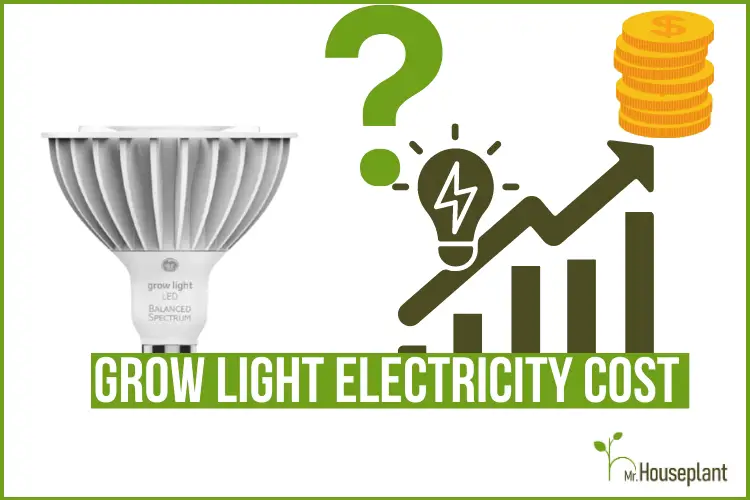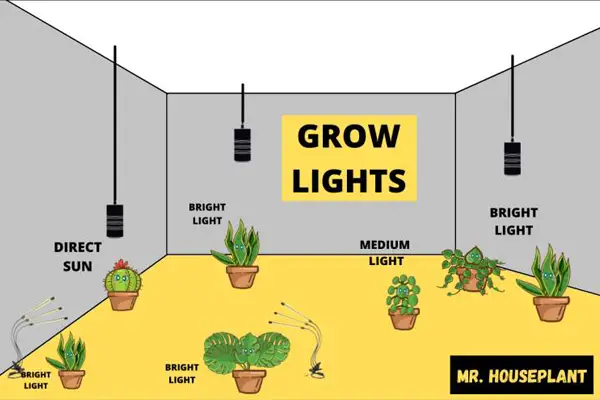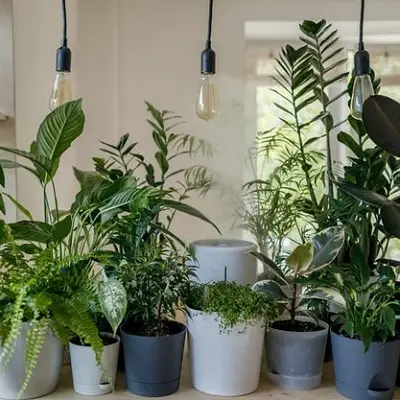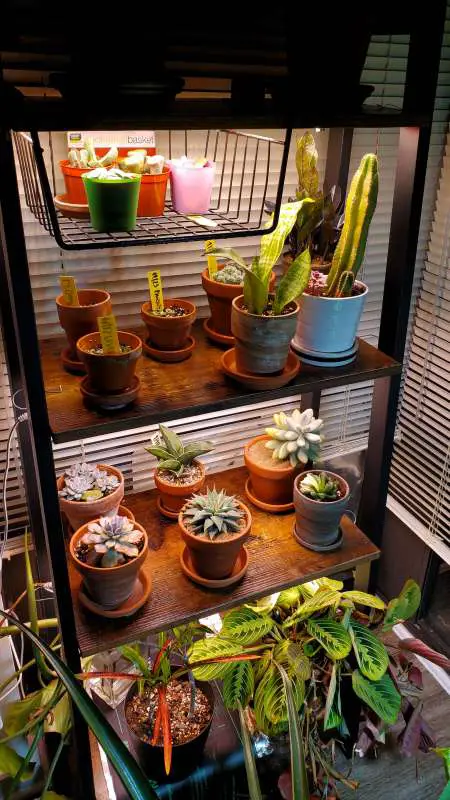
If you’re worried about your grow light electricity cost, I’ve got some good news for you!
Your electricity bill won’t be affected as much as you may think because most grow lights are built to be energy efficient. You just need to choose carefully. Read all the way to the end of the article to learn how to reduce your electricity costs when running grow lights.

As a plant lover, you know that light is plant food and that plants cannot live without it. The more light you can provide, the happier and healthier your plants will be. More light provided by grow lights helps your plants to photosynthesize more, grow faster, and produce bigger leaves and more sugars for their development.
To determine a dollar figure you can expect to pay with the expenses of grow lights added to your monthly bill, consider the following:
1. Grow light type
Not all grow lights are created equal. I recommend LED grow lights because they are efficient and provide good-quality light without emitting excessive heat. Unless you are buying large LED lights to cover a large number of plants, such as this Spider Farmer grow light, you will barely notice a change in your electricity bill.
If you’re not sure what type of grow light to choose, check out my Grow Light Finder. Just type a plant name and get a list of recommendations for excellent grow lights. You can also search by grow light type (standalone, grow bulb, shelf light/strip light, clamp light) or other criteria. It’s global, so you’ll be able to find grow lights in the US, Canada, the UK, Spain, and other countries.⠀
2. Grow light brand
Also, always go with well-known brands because they come with a warranty, provide great quality, and have higher efficiency than off-brand products. Pay more initially for a good-quality grow light to pay less later on a monthly basis for your electricity bill and to not have to replace the light as fast as off-brand products. Some of the well-known brands are Sansi, GE and Rousseau.
3. Wattage
A 20W grow light that’s on for 12 hours a day costs me 1.15USD/month. A 40W grow light that’s on for the same number of hours will cost me 2.3 USD/month in electricity.
The higher the wattage, the higher your electricity bill. All grow lights consume a certain amount of electricity. The amount of electricity they use is measured in watts (W). More watts = higher bill. You don’t want grow lights that will be too weak and there are many grow lights on the market that are not strong enough, so be careful when shopping. Try to find grow lights that will provide your houseplants with sufficient light but not skyrocket your bill. You can find many such lights in my Grow Light Finder. For excellent results, I recommend ACKE shelf grow light that uses 20W while acting as a 40W halogen or fluorescent bulb.

Have in mind that light intensity significantly drops with distance, so the greater the distance of the grow light from the plant, the less light will reach the plant. It will help if you purchase a strong, high-quality grow light that you’ll place closer to the plant. This, of course, will also depend on whether the plant has bright-light or medium-light requirements.
Take a look at the image above. The black grow light in the image (which is actually Rousseau SparrowHawk grow light) can provide artificial light that is equivalent to direct sun if placed close enough to a plant. But if placed further away it will provide bright light, or even medium or low light if placed very far.
4. How many grow lights will you use
This depends on how many houseplants you have and how big of an area you need to cover. Obviously, if you’re running a lot of grow lights, you will pay more than if you were running just one or a couple of grow lights.
5. How long will you keep grow lights running
This mostly depends on whether you’re supplementing natural light or you’re fully replacing it. If you’re replacing natural light fully, grow lights should run for about 8 to 16 hours but if you’re just supplementing it, a few hours will be enough. Most of my lights are on from 12-16 hours per day. The longer you run grow lights, obviously the more you will pay.
If you’re not sure how long your grow light should stay on for different plant species, you can use the Grow Light Finder to easily find out and save money, avoiding keeping them on when not necessary.
6. Local energy cost
How much do you pay for electricity in your home? The price will be different depending on the country or state you’re in and the electrical company you are using (in the US you can usually choose between multiple companies):
For example, my electricity cost is 0.16$ per kilowatt-hour (kWh). You can find this cost on your electricity bill. This means I’m paying 0.16$ per every KW used for every hour. Since 1KW is 1,000 Watts, this means I’m paying 0.16$ for every 1,000 Watts used every hour.
For example, if I had a 100-watt floor lamp running for 10 hours, it would use 1,000 Watts (or 1 KW) of electricity during that time. And these 10 hours of running the floor lamp would cost me 0.16$.
Let me show you how much I am currently paying for grow light usage. I am currently using the following grow lights:
3 x ACKE shelf grow lights: 22W *16 hours * 30 days = 10,560 W per month / 1,000 = 10.56 KW per month * 3 lights = 31.68 KW per month * 0.16$ = 5.06 USD/month
1x Rousseau SparrowHawk grow light: 40W *16 hours * 30 days = 19,200 W per month / 1,000 = 19.2 KW per month * 0.16$ = 3.07 USD/month
3 x Sansi 15W grow bulbs: 15W *16 hours * 30 days = 7,200 W per month / 1,000 = 7.2 KW per month * 3 lights = 21.6 KW per month * 0.16$ = 3.45 USD/month
2x Sansi 36W grow bulbs: 33W * 16 hours * 30 days = 15,840 W per month / 1,000 = 15.84 KW per month * 3 lights = 47.52 KW per month * 0.16$ = 7.6 USD/month
1x GE 32W grow bulb: 30W *16 hours * 30 days = 14,400 W per month / 1,000 = 14.4 KW per month * 0.16$ = 2.30 USD/month
In total I’m paying 21.48 USD/month for my grow lights. This is not much considering I’m running 10 grow lights and growing dozens of plants under them.
Use a Grow Light Electricity Calculator
To get really precise about your electricity bill with added grow lights, use this Grow Light Electricity Calculator I created. You can find out how much electricity grow lights will use in less than 30 seconds by entering a few simple pieces of information. It gives you realistic expectations of the costs of using grow lights for your houseplants.

Photo credit: Vadim Kaipov, Unsplash
How to Lower Your Grow Light Costs
If you’re growing just a few houseplants, you probably won’t even notice the difference in your electricity bill once you start using grow lights. But if you have a lot of plants or an indoor jungle like me :) then you can think of ways to reduce your expenses.
- Reduce the amount of energy you’re spending by switching to more efficient and long-lasting LED grow lights. A U. S. Department of Energy (DOE) report examining the energy-saving potential of LED lighting in horticultural applications found that LED grow lights offer a 24% to 30% reduction in electricity consumption compared to traditional lighting technologies. If you’re using incandescent lights switch to LEDs right away to save money.
- Switch to a more affordable electric company. If your country/state has multiple electricity providers, see which one has more affordable prices and make the change.
- Keep your grow lights on during the least expensive time period of the day. In my home country of Serbia for example, using electricity during the night is several times cheaper than during the day. If your state/company has this possibility, use grow lights during less expensive periods of the day.
- Reduce the number of hours grow lights are on. Let’s say you’re keeping your monstera under a grow light for 16 hours. Perhaps keeping the light on for only 12 hours would still keep her happy? Try it for a month or two and see how the plant is reacting. Whether the new leaves are getting bigger or smaller, whether they are getting more fenestrations or less. If the leaves continue to grow bigger and develop more fenestrations than the reduced number of hours will most likely be ok. And your electricity bill will go down.
- Use the available natural light, if there is any. If it’s a bright, sunny day, and your plants are close to the windows, you might not need your grow lights. In that case, turn them off, even if for only a couple of hours. You could even set them to turn off and on automatically, by using one of these timers.

My grow light shelf with ACKE grow lights
Have More Questions on Energy Efficient Grow Lights?
Don’t let the lack of natural light stop you from growing the houseplants you love and enjoy. With energy-efficient grow lights, you can get huge amounts of growing power for your houseplants while saving money.
I hope you now have all the information you need and your mind is set at ease but if you still have some questions regarding grow light expenses, don’t hesitate to let me know. Schedule a consultation with me, I’ll be happy to help!⠀
Yours Truly,



Related Posts
Spider Farmer Grow Light Review (JULY 2023)
Soltech Solutions Vita Grow Light (2023)
Briignite Grow Lights (June 2023)